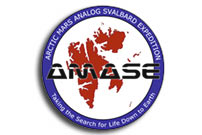NASA Arctic Mars Analog Svalbard Expedition Field Report (AMASE 2007): Getting Down to Business

08.17.07
Today was a wonderful day conducting the first rover field test on the Redbeds. After spending all day outside on a large rocky slope and watching the weather go from cold and snowy to blue skies and sunlit glaciers, I’m as happy as a clam.
We knew today was going to be a long day outside with rover. The morning was made rougher by the late night we had at Monaco glacier yesterday. I could not keep from yawning continuously as we scampered about the deck preparing for the days’ activities. Hans, Marilyn, and Terry went out first to hunt for a good rover deployment site. As the rest of us were awaiting their return, it started snowy big fluffy flakes on deck! This was not good for rover electronics of course; luckily this brief flurry passed and we did not have any precipitation for the rest of the day.
Out in the field, we set up another rover mission operations test. This time we actually had the Cliffbot rover operating in the field while the science working group sat a short distance away in a gully. I was asked to be the SOWG Chair for this activity and I found it more captivating than the previous days’ test. The main differences were that we were outside, had a much smaller science group and had to make decisions much faster. Our science group consisted of Gerhard, Jorge, Pablo, Ivar, Hans, Will, and myself. Our mission manager was Steve and he once again had to come up with a slew of curious mishaps to explain why we could or could not get the data we wanted from the rover. Our ultimate objective was to explore a gully on “Mars” by searching for interesting rock targets to image and finally select a soil target for sampling. We had fifteen minutes at the most to plan each Sol’s activities (real MER operations are on the order of 6 hours). The smaller SOWG allowed us to discuss our hypotheses and plans quickly. After four Sols we had taken some contextual images of the field site, driven the Cliffbot down a gully wall, taken microscopic images and UV fluorescence measurements of a rippled rock, and taken a soil sample.
Our science group was hidden from the rover for most of this exercise so we had to rely on its onboard instruments to explore the field site. After we uplinked our final sampling instructions we ran around to the rover’s gully to watch it in action. As soon as we saw the field site with our own eyes we began seeing things we had missed in the images and misconceptions we had generated. The most embarrassing mistake was not seeing a beautiful armored fish head fossil in a rock adjacent to the one we had sampled! Since our objective had been to search for habitability, the fossil would have been an amazing find! It was so obvious with our own eyes, but in the black and white images taken at a sharp angle from the rover, this feature had been invisible. This dramatically illustrated the difficulties of robotic exploration.
We’ll have each instrument team look at the samples the rover collected as well as the fish fossil when we get back to the ship.
We finally got all the gear down from the Redbeds and back to the ship around midnight. My hair is tangled and cheeks are red from the wind. Time for bed.
About Kirsten Fristad in her own words…
Kirsten Fristad here again. I’m privileged and excited to be back writing Notes from the Field on AMASE 07. I am a planetary scientist working in the Sample Analysis on Mars (SAM) Lab at the Goddard Space Flight Center in Greenbelt, Maryland where I have been for the last year and a half. I graduated from Macalester College in 2005 with a major in geology and core in astronomy knowing I wanted to pursue a research career in planetary science. Through summer internships with several planetary scientists, I developed a background in analyzing martian and lunar planetary remote sensing data and Mars analog field work in Alaska. Over the last year I have continued to organize the Goddard/SAM Team contribution to AMASE, conducted organic analyses of AMASE samples, designed and built new field hardware and participated in two other expeditions in Utah and the Mojave.
Following AMASE 07, I will be staying on in Norway as a Fulbright Scholar to begin graduate work at the University of Oslo. I am very much looking forward to exploring more of this beautiful country, reconnecting with the country of my ancestors and filling up on pickled herring and lefse!








